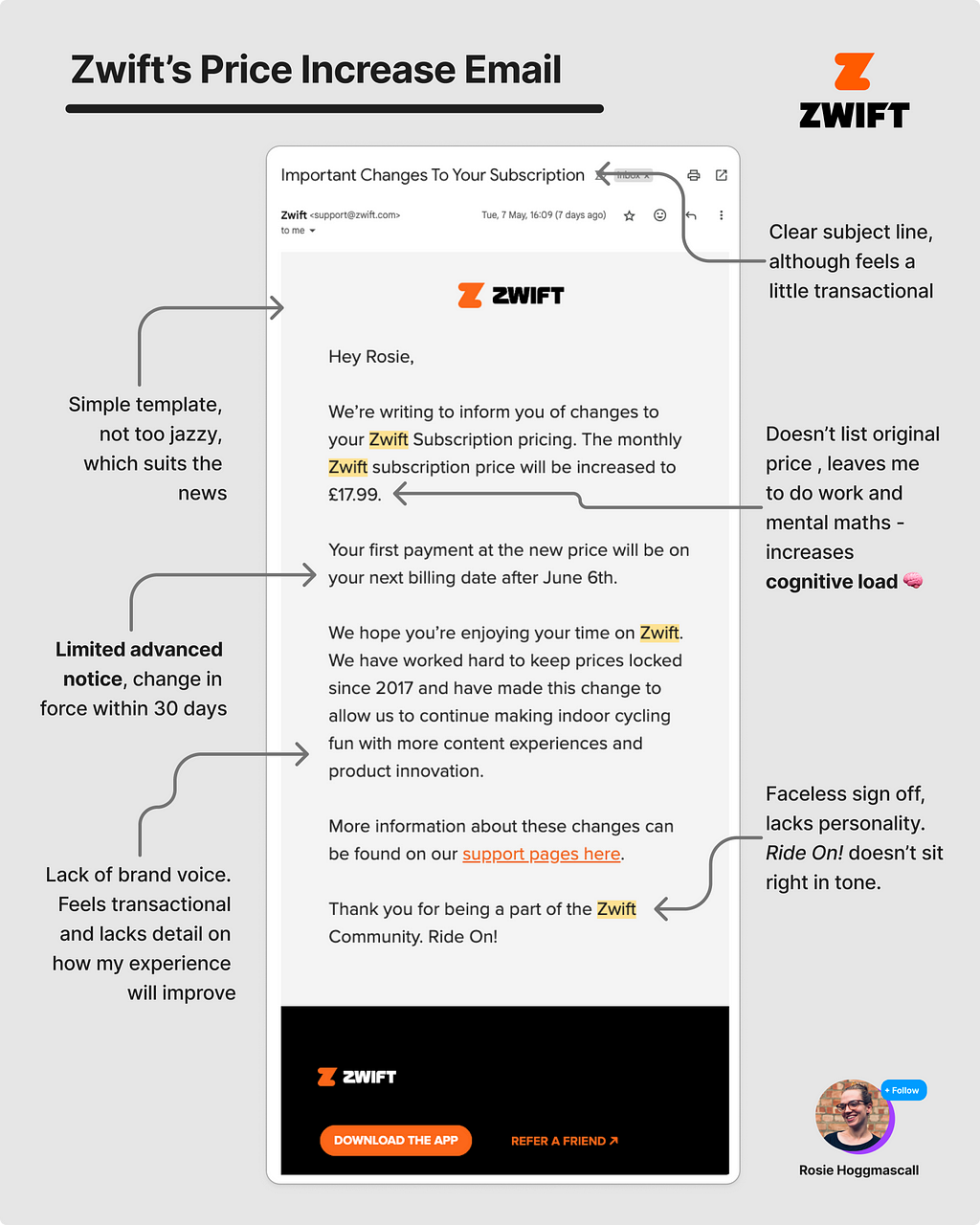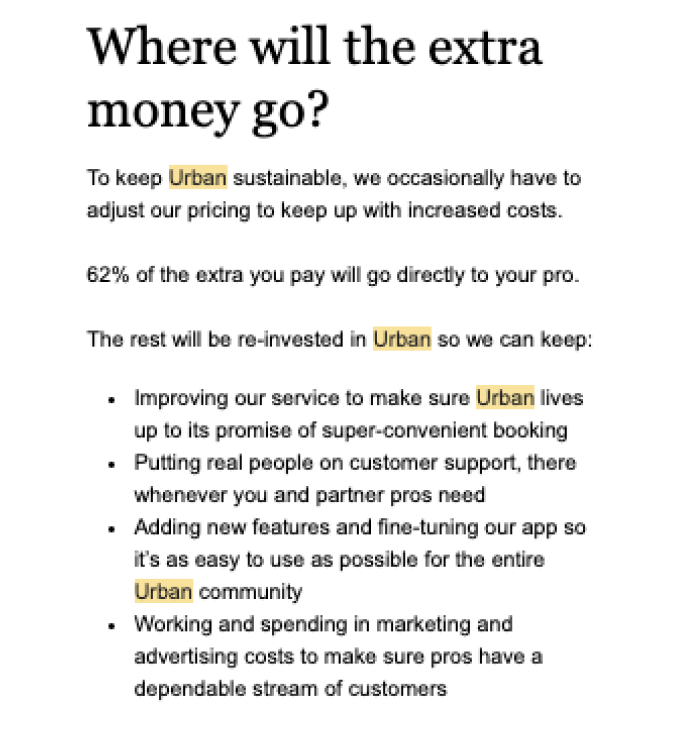The dos and don’ts of price rise emails.

Two months ago, I started virtual cycle trainer Zwift to help train for a triathlon.
At the time, it was raining outside, it was cold, and my bike had gathered so much dust from lack of use.
If you don’t know Zwift, think Peloton for cycling keen beans.
For £12.99 a month, it was super cheap for the value.
However, now the weather has started to heat up. I’m out on my bike more now in the **fresh** London air.
But last week, I got this email:
Important changes to your subscription
🚨🚨🚨
It was a price rise email — not an easy thing to do by any means. And not just any price rise: near 40%.

Even though I love the product, the email was lacklustre.
Not only because I’m a new user and I’m not ‘hooked yet’ (this was the third email I received from them ever) but also because of the content of the email.

It left me lacking confidence after reading. So much so that I’m cancelling my subscription.

So, let’s look at the do’s and don’ts of price rise emails using Zwift as a case study, sprinkled with some examples from other products too. We’ll run through:
- What messaging should you use?
- How do you explain the ‘why’ around the price rises?
- How far in advance should you send the communications?
- How are subscription products handling price rises now?
Before diving into the don’ts, let’s be positive and optimistic this week and start with what you should definitely do when raising prices for customers.
✅ The Do’s
✅ 1. Inform your customers
It may feel basic, but the first rule is let your customers know.
This first point is crucial. And — surprisingly — not always done.
Many subscription products don’t inform users of price rises with their own emails. Instead, they leave the subscription provider to send the email after the change is made.
Take AllTrails.
Last October, I received the mandatory, automatic email from Apple stating that my subscription would increase to 35.99/year. A 20% rise from 29.99/yr.

I received no email from AllTrails beforehand letting me know why.
Since 2022, apps have been allowed to raise prices without requiring opt-ins from customers.
What this means, is some apps try to fly under the radar and sneak a rise in without letting users know proactively, hoping they’ll miss Apple’s notification in their inbox.
Personally, I think this comes down to a fear of churn. The thought:
If we tell them they’ll cancel
Realistically, they’ll find out sooner or later. Apple will always send the notification.
If you’re not confident users will stick around with the new price, ask: is your product providing enough value? Have you done enough research?
It leaves us you some harder questions to answers if the answers are ‘no’ here.
At the end of the day, if you’ve not communicated price increases to customers and they’re left surprised when they find out, you erode trust of your brand in the long run for short term gains.
✅ 2. Don’t beat around the bush
In your email copy get to the point quickly. We don’t need an essay or Founder story beforehand.
In 2022, eco-friendly toilet paper subscription Who Gives A Crap increased their prices.
What was nice is that the email felt personal.
What was annoying was that it took five paragraphs to get to the price change. And the previous price was nowhere to be found. Leaving me to ask customer support what this meant for me.

Ideally you cut to the chase in the email with the ‘what’ straight away.
A successful price rise email means customers don’t have to contact support to find out more.
Take Bulb, a UK energy provider that went into Administration in 2021, then taken into Octopus Energy later on.
In their price rise emails, they went as far as to let customers know in the subject line the ‘what’ and the ‘when.

People appreciate you cutting to the chase with bad news.
You’re managing expectations well when you’re clear and direct in the delivery.
✅ 3. Calm the fears and anxieties in the future
What questions will people have? What will they want to know?
Add these in the email.
Things like:
- Is this the best deal?
- Will it go up in future, or go down?
- When will the payments change?
Bulb used to do a nice FAQ at the bottom of their emails with more information. This helps out customer support by answering questions that may come into them.

✅ 4. Tell them the why
It is important to tell people why you are increasing prices (and not just blame inflation.
Take Urban Massages. This is example is from B2B Head of Growth Anna Tankel, who explains:
This 2023 price increase email from Urban made a real impression for being very human, brand-led, and extremely clear. It was so memorable that — whilst only using the product 3 times ever — I remember the email from over 12 months ago. That’s impressive.
Whilst the email is long, it does some things really well:
- Gets to the point quickly with the what and the when in the title + first paragraph
- Gives a huge amount of information on where the money will go
- Has a key message of ‘fairness’ towards their providers, which resonates well

With the Zwift email, I’m thinking what product changes are coming? Am I going to get new routes? Will I increase my cycling game by 40% to match the price rise?

I am given the option to go to an online FAQ page, however the benefits listed are already available to subscribers and the copy feels more transactional.

There’s nothing here which is making me excited for what’s to come.
❌ The Don’ts
❌ 1. Blame inflation
This is so common.
We see with not only Zwift, but also Who Gives a Crap, a common explanation is inflation.
But this doesn’t cut it. It risk-averse as a mindset and communicates that either:
- The business doesn’t plan well
- The business isn’t in control
These two things don’t instill confidence. They also lead to lack of trust, as in periods of lower prices and inflation, subscription prices don’t come down.
So it feels more of an excuse than anything.
Instead, the ‘why’ should lead with the value proposition and the promise of future value to be created with the new funds.
Just like Urban Massages.

❌ 2. Poor timing & no advanced notice.
With Zwift, I’m told that my subscription will change from next month.
Wait what? In 30 days?

Feels cheeky to have the change enforced from the next billing date. Ideally you want to let customers know well in advance.
If you’re a cyclist, you’re in two camps. A no-cycling-in-winter cyclist, or an indoor cyclist. Zwift is a GODSEND in winter. Not summer.
Which also means that this email was incredibly poorly timed with the seasons and northern hemisphere user behaviour.
So two learnings here: tell people in advance, and pick the right time of the year. For instance:
- If you’re an alcohol subscription, don’t do it around dry January
- If you’re a parents-focused subscription, don’t do it around busy periods like Christmas
- And, if you’re an indoor cycling product, don’t do it just before the hottest part of the year.
Again, feels obvious, but apparently not for some.
❌ 3. Lack of Personality
Money is personal. So the emails need to be personal too.
To me, the brand voice of Zwift does not come through.
Instead, it feels clinical and transaction, until the ‘ride on’ sign off — which feels jarring because of this difference in tone.
Specifically
We hope you’re enjoy your time on Zwift
Well no actually, when I did my cycling fitness test (ramp test) I was in so much pain and sweat it was unreal.
Instead, perhaps something with social proof could have been more compelling here:
80,000 cyclists took to Zwift this year. And you were one of them. We’d like to thank you for your blood, sweat and tears.
Or perhaps:
You cycled with the pros this year like MDVP (Mathieu van der Poel), Pidders (Tom Pidcock) and Pog (Tadej Pogačar)
Whatever is more in-line with the value proposition.
Additionally, ideally this email would be sent from the CEO or a real person to give it more authenticity and authority.
The way it currently feels is like a faceless, transactional email. No sign off. No face. No genuine show of care or understanding of the user experience.
❌ 4. Transparency in the before price
In the Zwift email, I’m told what and when, but not how much I’m currently paying.
Meaning I’m left to do mental maths and find out myself how much this will affect me in reality.
When I do the calculations, I find I’m going to be paying an eye-watering £215 per year, a whopping 40% more. And only 2mo since I joined.
Would you rather:
- A: Customers find out exactly how much this means by themselves (because they will)
Or
- B: You manage the messaging around the price fully, and communicate why this value is right.
I’d go for 2
What could Zwift have done differently?
What I would have preferred is an email that’s more compelling. Something more convincing and something that reflects actual user behaviour.
Something authentic, empathetic and personalised.
Something like:
Pause your subscription for the summer season, and let it kick back in when autumn hits
As a new users, we’re giving you [personalised offer] as we know you’ve not quite got the most out of Zwift yet.
Switch to annual now to save 15% off the new price
Perhaps this would help save the brand image, as well as reduce the number of summer cancellers.
From asking friends, I know that many Zwift users used to leave the cheap subscription on over summer as it wasn’t a big deal.
Now with this near-£20/mo, it is worth cancelling.
I’m very interested to see if this overall price hike is a loss or a win for the business.

What about after summer?
And crucially, will I re-subscribe?
Probably, yes.
The data network effect is HUGE. With all my fitness tests and the like on there.
And the product is great. Just not right now, when the sun is shining and I want to get outdoors.
Till later Zwift 👋
See you in 6mo time
Price rise emails are quite hard to find, would love to see more examples in the comments if you have any
I’m cancelling my favourite subscription. Here’s why. was originally published in UX Collective on Medium, where people are continuing the conversation by highlighting and responding to this story.


Leave a Reply